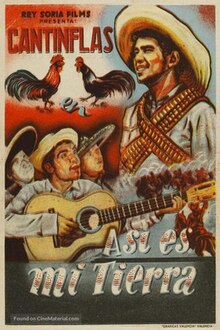| Such Is My Country | |
|---|---|
 | |
| Directed by | Arcady Boytler |
| Written by | Arcady Boytler Enrique Uthoff |
| Produced by | Pedro Maus Felipe Mier |
| Starring | Cantinflas Manuel Medel Antonio R. Frausto Luis G. Barreiro Mercedes Soler Juan José Martínez Casado |
| Cinematography | Víctor Herrera |
| Edited by | José Marino |
| Music by | Ignacio Fernández Esperón |
| Production company | CISA |
| Distributed by | Artistas Unidos de México |
| Release date |
|
| Running time | 82 minutes |
| Country | Mexico |
| Language | Spanish |
Such Is My Country (Spanish: ¡Así es mi tierra!) is a 1937 Mexican comedy film directed by Arcady Boytler and starring Antonio R. Frausto, Mercedes Soler, Juan José Martínez Casado, Manuel Medel, and Mario Moreno, better known by the stage name Cantinflas. It was the first film to feature Cantinflas in a prominent role (his film debut Don't Fool Yourself Dear only featuring him in a brief appearance) and the first of Cantinflas's films together with Medel as a team.
The film's sets were designed by the art director José Rodríguez Granada.
Plot
In 1916, in the middle of the Mexican Revolution, a General (Antonio R. Frausto) returns to his home village, where he is received with a great party. The general is interested in the young Isabelita (Mercedes Soler), without knowing that she already maintains a secret romance with Filomeno (Juan José Martínez Casado). Meanwhile, "El Tejón" (Cantinflas), a farmhand who idolizes the General, and Procopio (Manuel Medel), the General's right-hand man, are vying for the love of ranchwoman Cholita (Margarita Cortés).
Cast
- Cantinflas as El Tejón
- Manuel Medel as Procopio
- Antonio R. Frausto as General
- Luis G. Barreiro as Licenciado
- Mercedes Soler as Isabelita
- Juan José Martínez Casado as Filomeno (as J.J. Martinez Casado)
- Margarita Cortés as Cholita
- Amelia Wilhelmy as Adelita
- Josefina Segarra as Doña Tomasa
- Ángel T. Sala as Compadre Gallo
- Miguel Wimer as Cayetano
- Luis Ureña as Nicanor
- Ángel Arzamendi as Don Chon
- Guillermo Calles as Gonzalo
- Antonio Garay as Gómez
- Ana María Castañeda as Restituta
- Carolina Barret as Carolina (uncredited)
- Leonor Gómez as Lupe (uncredited)
- José Elías Moreno as Party guest (uncredited)
- Alicia Reyna as Cook at party (uncredited)
- José Ignacio Rocha as Party guest (uncredited)
Analysis
The authors of Mexico: An Encyclopedia of Contemporary Culture and History argue that the film parodied the comedia ranchera film genre, saying, "Given his decidedly un-macho persona, it seems appropriate and hardly coincidental that the first target of his humor was that the most manly of Mexican film genres, comedia ranchera." Michael Werner in his Concise Encyclopedia of Mexico complimented the "Eisensteinian aesthetics that Boytler incorporates" to the film. Conversely, in his books Escenas de pudor y liviandad and Los ídolos a nado: Una antología global, Carlos Monsiváis stated that Cantinflas's pelado character was incompatible with the rural setting of the film, in contrast to the city setting of his later films, saying that " is the new urban sensibility." In his book Más allá de las lágrimas, Isaac León Frías collects Aurelio de los Reyes's criticism of the film's limited exterior filming, contrasting it with Allá en el Rancho Grande saying, "It tries to capture the return home of the revolutionaries, but the return is a pretext for the action to take place 'inside walls' on film sets. Outdoors and natural settings take second place, the opposite of Allá en el Rancho Grande. It takes refuge in the studios perhaps because another reality is more comfortably manufactured there."
References
- García Riera, Emilio; Macotela, Fernando (1984). La guía del cine mexicano de la pantalla grande a la televisión, 1919–1984. Editorial Patria. pp. 15, 35. ISBN 9789683900296.
- Agrasánchez, Rogelio (2001). Carteles de la Época de Oro, 1936–1956. Chronicle Books. p. 1930. ISBN 9780811830584.
- ^ Werner, Michael (2015). Concise Encyclopedia of Mexico. Routledge. p. 489. ISBN 978-1-135-97370-4.
- Criollo L., Raúl Alberto (1998). Tendencias del cine mexicano de los años 30. CONACULTA. p. 81.
- Coerver, Don M.; Pasztor, Suzanne B.; Buffington, Robert (2004). Mexico: An Encyclopedia of Contemporary Culture and History. ABC-CLIO. p. 59. ISBN 1-576071-32-4.
- Monsiváis, Carlos (2016). Escenas de pudor y liviandad (in Spanish). Penguin Random House Grupo Editorial México. pp. 87–88. ISBN 9786073148245.
- Monsiváis, Carlos (2011). Los ídolos a nado: Una antología global (in Spanish). Penguin Random House Grupo Editorial España. p. 92. ISBN 9788499920580.
- León Frías, Isaac (2019). Más allá de las lágrimas: Espacios habitables en el cine clásico de México y Argentina (in Spanish). Fondo Editorial Universidad de Lima. p. 266. ISBN 978-9972-45-486-8.